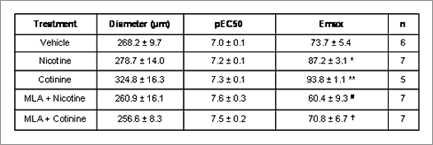Effect of nicotinic acetylcholine receptor stimulation on endothelial-dependent relaxation in rat mesenteric arteries Neuronal type nicotinic acetylcholine receptors (nAChRs), in particular of the α7 subtype, are expressed on vascular endothelial cells (Bruggmann et al., 2002), where their function remains unclear. Previously, we have found that exposure of rat mesenteric arteries (Chadha et al., 2004), though not pulmonary arteries (Chadha et al., 2005), to nicotine prevents the decline in endothelium-dependent relaxation that occurs upon prolonged storage of vessels in culture. In the present study, we have investigated acetylcholine-induced relaxation in rat mesenteric arteries, following a 48 hour exposure of vessels to nicotine or its major metabolite, the weak nAChR agonist cotinine, in the absence and presence of the α7 nAChR-selective antagonist methyllycaconitine (MLA). Male Wistar rats (240-260g) were killed by CO2 asphyxiation. Mesenteric resistance-like arteries (third generation) were dissected and treated with 6-hydroxydopamine (2 mM) and capsaicin (0.1 mM) for 30 minutes (Shiraki et al., 2001), in order to remove neuronal influences. Following this, some vessels were incubated in DMEM containing nicotine (10-7 M) or cotinine (10-7 M), both alone and in the presence of MLA (10-7 M). 48 hours later, 2 mm segments of artery were mounted on a wire myograph under normalised tension in oxygenated (95% O2/5% CO2) Krebs’ buffer maintained at 37°C. Maximum contraction to KCl (120 mM) was initially determined and sub maximal tone subsequently induced using phenylephrine (0.1-10 μM), in the presence of nifedipine (0.3 μM), before assessment of ACh-induced relaxation. Maximal responses to ACh (E max) are expressed as percent relaxation of active tone (mean ± SEM) and differences determined by ANOVA, followed byDunnett’spost test. Table 1 Mesenteric arteries (48 hour incubation): ACh-induced relaxation.
* P<0.05, ** P<0.01, denotes difference between vehicle and agonist-treated vessels. Nicotine and cotinine exposure enhanced subsequent maximal endothelial-dependent relaxation of mesenteric arteries, in response to ACh (Table 1), an effect that was abolished by co-exposure to MLA. These data suggest that endothelial nAChRs may possess a role in control of vascular tone in certain vessels.
Bruggmann D et al. (2002). Histochem. Cell Biol. 118, 441-447. |
|


